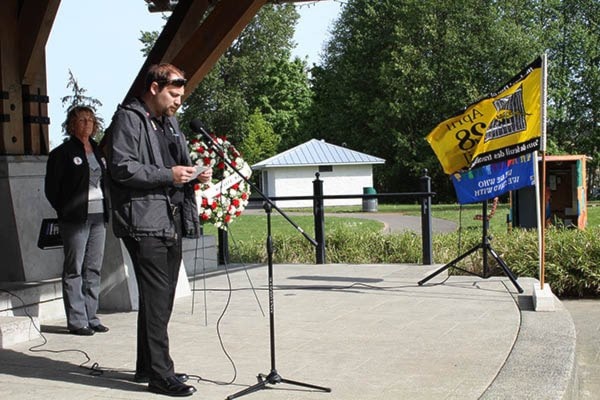The City of Courtenay, WorkSafe BC and CUPE 556 honoured fallen workers at the annual Day of Mourning flag-raising ceremony Thursday at the Simms Park Pavilion. The event served as a reminder that proper safety procedures are necessary to save lives on the job.
“Nobody expects that when they go to work that they’re never coming home,” said Paul Stephens, senior prevention officer at WorkSafeBC.
Bob Wells, speaking on behalf of Courtenay council, said the ceremony provides an opportunity to “reflect on how we embed a culture of workplace safety in our own lives.”
Last year, WorkSafe BC awarded the City of Courtenay with a certificate to recognize its health and safety program. But Wells also noted sad news came last November when senior captain Tom Slater of the Courtenay Fire Department passed away after a brief battle with a complication of his lymphoma. WorkSafe BC says Slater’s illness was likely a result of his firefighting duties.
Wells knows firsthand how it feels to lose a loved one for work-related reasons. At age 10, he lost his father through a workplace accident.
“We must remain vigilant to ensure we do our very best to protect our workers, and honour those who have been injured or lost their lives to ensure that their sacrifices are not made in vain,” Wells said.
“We can’t bring back those who have died, but we are working hard to make workplaces safer today,” said Anne Davis, vice-president of the Campbell River, Courtenay and District Labour Council. “That’s why this April 28th, unions across Canada are calling for a national ban on asbestos, a known killer that causes disease, suffering and death — all of that preventable.”
Estimates indicate more than 2,000 Canadians die each year from diseases caused by exposure to asbestos — the number one cause of occupational death in Canada.
Since 1996, asbestos-related diseases have accounted for about a third of workplace deaths recognized by Workers Compensation boards. Nevertheless, Davis said imports of items such as brake pads and cement pipes that contain asbestos are on the rise.
“The lack of a formal national registry of buildings known to contain asbestos adds to the risk of needless exposure,” she said.
Over the past year, Davis said unions have been trying to reduce hazards faced by people who work in confined spaces. She also credits unions for efforts to foster workplace protection for victims of domestic violence.
“Recognizing that not all injuries are physical, unions are also taking on the stigma of mental illness, and factoring it into what makes a workplace healthy and safe,” Davis said.
According to WorkSafeBC statistics, 173 people in B.C. died in 2014 as a result of workplace injury or disease. Last year, 122 workers died.
“That is the lowest number in years, but it’s still far too high,” Stephens said, noting nine of the workers were from the Island.
“Most people are of the opinion that workplace deaths only happen in a typical high-risk sector such as construction or forestry. Well, of those 122 deaths last year in B.C., 29 of them were in the transportation, public administration, health care and education sectors. So the truth is, serious accidents can happen in any industry.”
